Canon EOS 7D Review: Noisier than 40D

Canon EOS 7D
Shortly after the announcement of the EOS 7D camera by Canon, I wrote a post here on my blog where I mentioned that the 7D looked like a very promising camera. Before I continue with my review of the 7D, let me take a moment to discuss some of the things I said in that previous post.
I mentioned right from the start that the noise in 7D images was a concern for me, this is what I wrote:
The only thing that I’m not so sure about right now is the image quality. Canon has included a new 18MP sensor in the 7D which, from the sample images I have seen so far, appears to deliver much better image quality compared to the EOS 50D even while having a higher pixel count, and comes close to the EOS 5D Mark II. I could see no pattern noise and banding issues so far, like I mentioned before, and this is a very good thing. However, looking at RAW files, I still think that the images produced by the 7D contain a little too much noise, even at lower ISO values, and the images at high ISO contain way too much noise. JPEG images coming out of the camera look better because of the noise reduction being done inside the camera, at the expense of lost detail, but RAW images look terrible so far.
As you will soon see, this is exactly the case. Another thing I mentioned was the following:
Looking at Canon’s recent DSLR releases and all the quality control issues they’ve had, it would be wise to wait at least 4 months after general availability before you actually buy a 7D, just to make sure that there aren’t any issues with it. You really do not want to spend money to become Canon’s beta tester. Wait for the reviews, read the experiences from those who were brave enough to buy one early and then decide.
And many of the people that couldn’t wait to buy the 7D are now experiencing exactly what I meant when I warned not to become Canon’s beta tester. Canon has so far had to release TWO firmware updates for the 7D in the very short time period of just one month that the 7D has been available. The first update (version 1.0.9) was to correct autofocus problems in Live View mode, and the second update (version 1.1.0) which was released a few days ago, was to correct a ghosting problem in images (Fake Chuck Westfall has more on this here). In addition to this, many people are experiencing autofocus problems with their 7D cameras. It appears that Canon’s quality control is still pretty bad and at this point in time, one has to wonder if it will ever get better. If you want some examples of people experiencing these autofocus issues on the EOS 7D, check out the following links:
1. Discussion at DPReview Forum
Unfortunately it looks like I’ve got a 7D that has the much-talked about Autofocus problem. I came back from the cottage last week with about 5 good images out of 600, all of the others were just blurry enough at 50% to make the image unusable, but still look fine when fit to the LCD. There was little consistency between back and front focusing, or the amount of error: AF is all over the place.
2. 7D Autofocus Problem Test with sample images
I ran series of pictures tonight on my camera in 19 point AF, zone AF, and spot AF. I’ll summarize the data and include all the photo’s below. I also took some with my Sony F800, it’s a bit above the point and shoot, but not a DSLR.
…
Most of the badly out of focus results ended up front focusing on the near floor which is supposedly out of the AF range. 19 point and zone auto focus seemed to almost be working randomly.
The first day shooting was dismal and the light not the best so I didn’t pay much attention to the results. However, most images were soft. I was shooting on Sydney Harbour so conditions were not ideal in the late afternoon. I can tell you that distant foliage looked like an impressionist painting. I was very disappointed because I often shoot landscapes. The Jacaranda blossoms are out now in Sydney and I really love capturing the colours. Not sharp and not quite an accurate colour compared to the 5DII which is quite close to being right. I used my 200 f/2.8 lens which I knew was sharp on the 5DII but this was soft on the 7D for some reason.
The next day was bright and sunny so I returned with tripod and 500mm lens. I also tried a 70-200 f/4is lens but nothing was sharp. I used the 500 with the 1.4 extender to capture people on top of the Harbour Bridge and did the same with my 5DII as a comparison. I have shot climbers heaps of times so used a cable release as well. Most of the results were soft. Earlier in the day I used the 24-105 with the 7D and the results were good. The distant shots were a bit soft but maybe it was my fault. When I got home and examined my tele photos I found that the mode dial must have been shifted because my telephoto shots were all at 1/125 sec. That setting made the apertures over f/20 so I blamed that for the unsatisfactory shots. For some reason the letters on signs weren’t captured properly and were somewhat faded or invisible compared to the 5DII.
Day three found me setting up my tripod again and having another go with the 500 plus 1.4 extender. I took a couple photos with the 500 by itself and the two were sharp. When I added the extender none of the shots were sharp. Letters on signs were smeared. I tried several subjects at different distances but all were quite soft. Some looked fine at 25% but none at 100%. I then took a dozen photos with the 70-200 f4 and expected good results. It was sunny and bright but all were soft.
…
There was a lot of noise in many of my photos so I don’t think I will venture to buy another camera with a 1.6 crop factor. The 5DII in my opinion is a professional quality camera compared to the 7D. I certainly don’t want a camera that can’t focus or that has issues. Let us hope Canon sorts these problems out.
These are just 3 examples, but reading those threads and doing a simple search will reveal many more people experiencing the same issues. I see more people complaining about this almost daily. There are also people who are satisfied with the 7D autofocus system, so at this point it looks like these autofocus issues could be related to a quality control problem at Canon and are not a defect / shortcoming of the autofocus system itself (like was the case with the 1D Mark III and 5D Mark II). At least I hope so for those of you who bought the camera. So should you choose to buy this camera, be prepared to give it a lot of testing as soon as you get it to make sure your copy does not suffer from these issues. I’ve also seen reports from people who have sent their bad focusing 7D cameras to Canon for repairs and received it back working much better. Certain stores don’t even question you when you return the 7D mentioning bad autofocus, leading me to believe that most of them are aware of these issues.
These issues with the 7D add to what is already becoming a long list of quality control problems that Canon has had with recent DSLRs and lenses. If you want some more background information on Canon quality control problems, check the following links:
- Canon Quality Control Sucks Part 1 and Part 2
- Canon has Lost It
- Issues with 5D Mark II Autofocus
- EF 50mm f/1.2 L lens backfocus issues
- Interview with Fake Chuck Westfall at Black Star Rising
- Fake Chuck post discussing some Canon issues
Not too long ago, photographer Lloyd Chambers wrote about his experiences with the autofocus of the Canon EOS 1D Mark III and said the following:
This latest AF issue follows on the heels of a Live View exposure problem with the Canon 5D Mark II. I think it’s fair so say that with 3 professional camera models with issues, this firmly establishes Canon as having a track record of not testing products adequately. And at the cost of customer time, hassle, and perhaps money.
And you can now add the EOS 7D to that list of Canon professional camera models with issues.
All of this is rather disappointing because like I said in my first post about the 7D, the 7D looked like a very exciting camera. Canon added a lot of exciting new features to it that were long overdue:
The 7D seems to be Canon’s answer to the Nikon D300s, and it looks like it will give the D300s some good competition. There’s a lot that I like about the EOS 7D, such as the new 19 point AF system, 8 fps shooting speed, the new metering system, the intelligent viewfinder with 100% field of view, 1.0 magnification, and overlaid LCD display. Also the fact that you can now finally use the built-in flash to trigger external Canon flashes wirelessly (without an ST-E2).
Those are, in my opinion, the most important features that were added tot he 7D compared to other camera models like the 50D. And those features alone would make the 7D a perfect upgrade for users of the EOS 40D, 50D, 500D and lower camera models.
However, like I mentioned before, there’s the problem that the noise in images taken with the 7D is still too much. The 7D is supposed to be a better performer in low light situations, but as it appears this is not the case. It certainly is an improvement compared to the 50D (which was absolute crap as far as image quality is concerned), but it performs worse than the Nikon D300s at lower ISO values, and worse than even the old EOS 40D. But don’t take my word for it, let’s look at some sample images below. I took those sample images from some reviews over at DPReview. I did ask Canon for a sample 7D body so I could do my own tests, but never got a response back from them. The images below are taken from the following review pages at DPReview: EOS 7D review, EOS 40D review, EOS 50D review, Nikon D300 review. So if you don’t believe what you see in the images below, feel free to go take a look at them at the source.
One thing I have to mention about the review of the 7D at DPReview, is that it seems to me like the reviewers at DPReview tried to remain positive about the 7D and ignored some of its issues. For one thing, they don’t test autofocus on cameras, and in the case of the 7D, they clearly fail to mention that the noise in the 7D images is worse than the noise in images taken with a 40D and even with the Nikon D300s. Here’s an example:
Again, the graphs below confirm what we can see in the sample crops. The 50D produces more chroma noise than the EOS 7D at higher ISOs. The Pentax K-7 is still slightly worse than the Nikon and EOS 7D at very high ISOs but the gap is smaller in RAW. At high ISOs the the 7D and its closest rival, the Nikon D300S, are more or less level in terms of chroma noise.
While discussing the test results, the commentary is worded in such a way that it makes the 7D look positive every time. When reading this, most readers would think the 7D is the best. What they failed to mention in this particular case, is that by looking at the graph and sample images, it is very clear that the 7D performs worse than the D300s at lower ISOs. I’m including some of their own test images together below and you can clearly see this in those images. This means that the 7D is even worse than the 40D, since the 40D is better than the D300 with regard to noise performance. And comparing the 7D with the 50D is like comparing a healthy human being with a disabled person, to be honest.
Let’s look at some of DPReview’s own sample images and see if the 7D is as good as they claim:
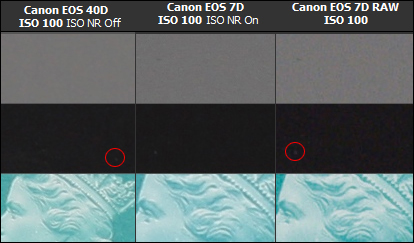
Here you can see that at ISO 100, the 40D clearly has less noise, even while noise reduction on the 40D was OFF (!!!) and it was ON on the 7D!! Just check the amount of noise in the 7D RAW file at ISO 100. When has it become acceptable to have this much noise present at ISO 100? I placed the red circles around some dust or marks, I discuss this further below.
As you can see, even at ISO 100, the 2 year old 40D beats the 7D with regard to noise performance. In fact, the 7D doesn’t beat the 40D even with noise reduction on! At higher ISO values, the problem only gets worse. Let’s look at another sample image. I labeled the images below from 1 to 4, 1 being the best and 4 being the worst, as far as noise performance is concerned to make it easier to compare.
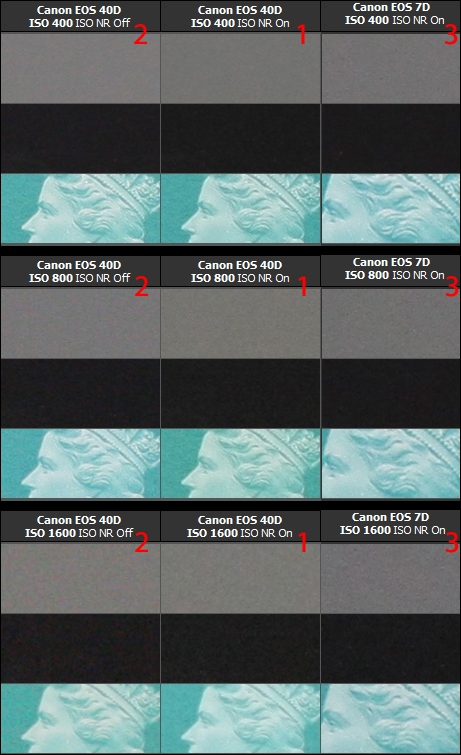
Here you can see JPEG comparisons between the 40D and 7D. As you can clearly see, the noise in the 7D images with noise reduction turned ON (!!!) is still much worse than the noise in 40D images with noise reduction turned OFF. So think of how much worse the 7D images would look, compared to the 40D, if the 7D images also had noise reduction turned off!
And now, let us look at the noise performance in RAW images:
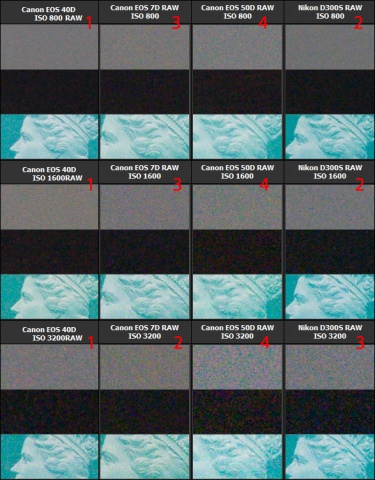
Click on the image to view the bigger version. In this RAW comparison, you can clearly see that the noise in 7D images is worse than the D300s at ISO 1600 and lower. DPReview did not mention this in their review where they discussed these same images. The 7D is much worse than the 40D. Only the 50D is worse than the 7D, but the 50D really is a piece of shit camera to begin with.
As you can see, one can come to “slightly different” conclusions by viewing the exact same test images that DPReview used in their reviews.
Image test results over at CameraLabs also support my conclusions above about the DPReview 7D review. Just look at the image comparisons at these links: RAW Comparison, JPEG Comparison. Notice how the 7D images look so much noisier compared to the D300s images.
This proves that my initial fears about noise in 7D images were certainly grounded. I’ve said it before, but Canon really doesn’t seem to care about what photographers are really asking for. With the 7D they did take care of a lot of things, but image quality is very important. We do NOT want more noise in larger images! This is not an improvement. Now the 2 year old 40D costing round $800 delivers better image quality than the ‘state of the art’ 7D which costs $1700. Does this make sense to you? Not to me!
Canon should have equipped the 7D with a 10MP or 12MP sensor featuring the same improvements in sensor design in the 7D. That would have guaranteed better image quality compared to the 40D. Yes, the 18MP 7D images have more resolution compared to the 10MP 40D images, but really, this is not of much use when the images are also noisier, and especially not at high ISO. It just gives photographers a lot more work to clean up noise in post production. In addition, more dynamic range and other benefits would also have been welcome on the smaller improved sensor.
Since noise in images can be seen more clearly in the out of focus areas, it really makes images that should have nice bokeh effects look uglier. Instead of images with nice creamy looking out of focus backgrounds, you get images with out of focus backgrounds that have kind of a rough and grainy feel to them, even at ISO 100. This can often be cleaned up in post production, but depending on the images, this can add a significant amount of extra time to your workflow. This is why I also always wondered why reviews everywhere on the Internet feature noise tests with images that are in focus. The best way to test the noise performance of a camera, is to take out of focus shots so you can see the noise much better. Take the sample images from DPReview above, for example. The noise test on the gray background should have been done by focusing on a large gray area, and putting the lens totally out of focus. That way you don’t get the dust, patterns and other texture of the background together with the noise – something you can often see in the DPreview noise test images (check the red circles in the test images above). You could even confuse the texture on the background as being noise if you don’t look carefully.
If you’re wondering why Canon isn’t giving us what we want, check out this article:
Canon engineers are being held back from developing new sensor technology by marketing departments in a “race for megapixels”, claims an employee of the Japanese photography company.
The employee told Tech Digest that Canon have the technology to “blow the competition away” in terms of image sensors, but are instead being asked to focus on headline figures like the number of megapixels a camera has. When asked for his opinion on the Canon EOS 5D Mark II, which we covered this morning, the employee said:
“I am hugely disappointed because once again Canon engineers are dictated by their marketing department and had to keep up with the megapixel race. They have the technology to blow the competition away by adapting the new 50D sensor tech in a full frame format and just easing off a little on the megapixels. Although no formal testing has been done on the new model yet, judging by the spec and technology used, it just seems to be as good or as bad as the competition – not beating them by a mile (which we used to).”
The employee was keen to point out though that he wasn’t wholly disappointed by the new model though:
“The image quality on the 5d1 was so good that it’s still as good as the new NikonD700 even though the Nikon is 3 years younger. I was hoping (…) for two new cameras. One would be a ‘reheated’ 5D1 with a same megapixel count but a slight redesign in sensor combined with new processor and all the gadgets like micro autofocus adjustments, vignetting control, dust reduction, better weather seals and an upgrade to the autofocus.”
“The other one would be a ‘revolution’ 5d, with a completely new sensor design (so it can actually take a lot more megapixels), dual processor for faster frames per second and the gadgets above with a ‘near’ professional grade autofocus for the sake of protecting the 1D series and model segregation”.
“To be honest I was hoping for a bigger upgrade, but they can’t please everyone with one model. (…) On the whole though, I think Canon have done pretty well in fending off competition on all sides – providing a viable upgrade to the 5d1 and worthy competition (on spec at least) to the competitors”
It’s true that megapixels are often used as a benchmark to compare cameras on, but until the media change their reporting style, the pressure from the marketing department will remain on the engineers.
As we know today, the 5D Mark II also suffers from a lot of noise and banding in images even at lower ISO values, as low as ISO 100. This is just unacceptable. It is very sad to see that Canon, while they clearly have the technology to deliver better image quality, choose to compete in the megapixel race instead and are delivering bad image quality. This while Nikon has just released their new D3s camera with an improved sensor that is “just” 12MP, and fullframe at that, capable of delivering results at extremely high ISO values. Nikon clearly appears to understand much better what photographers really need. Meanwhile Canon is giving us 18MP on a 1.6x crop sensor with a lot of noise at ISO 100, and a 21MP fullframe sensor with noise and banding at ISO 100.
When will we see an EOS 3D camera, with same or better specs than the 7D and a 12MP fullframe sensor using the latest sensor technology, that is capable of delivering smooth, creamy looking images not only at low ISO but even at the higher ISO settings? There’s a reason why people loved the image quality from the old 5D so much. Just realize that today Canon has the technology to improve on that, but simply refuses to.
So to conclude, as far as the 7D is concerned, I’m afraid I can’t really recommend it. It is certainly not a waste of money, like was the case with the 50D and 5D Mark II, as it does offer some nice upgrades compared to previous models. But if you require good image quality, then it is not the best choice. Clearly the Nikon D300s and certainly the Nikon D700 offer more here. If you are a 40D user, you don’t have to upgrade. If you are a 50D user, I feel very sorry for you and upgrading to the 7D is a good option, but downgrading to the 40D is perhaps better and more affordable. If you are a 5D Mark II user, I would consider upgrading, yes upgrading, to the 7D because images that are in focus most of the time win over images with a little more noise in them. Personally I will NOT be buying the 7D as long as the 40D remains available. I will be looking at the 1D Mark IV, hopefully Canon won’t screw up with that model.
Update November 11, 2009:
It is also important to take note of the fact that Canon themselves do seem to know about the benefits of lower megapixel sensors to achieve lower noise and as a result cleaner looking images. When Canon introduced the G11 compact camera, it featured a 10MP sensor, which was actually a step backwards compared to the older G10 camera, which had a 15MP sensor. Why would Canon introduce a newer G11 model which has less megapixels compared to the G10? Here is what Canon themselves say:
The PowerShot G11 employs a newly-developed, 10.0 Megapixel High Sensitivity System by combining a powerful CCD sensor and Canon’s DIGIC 4 Image Processor. Thanks to this technological advancement, the G11 is dramatically more sensitive than cameras with identical megapixel counts, and delivers spectacular images with minimal noise.
If you go over to that page, you will even see the following comparison made by Canon themselves:
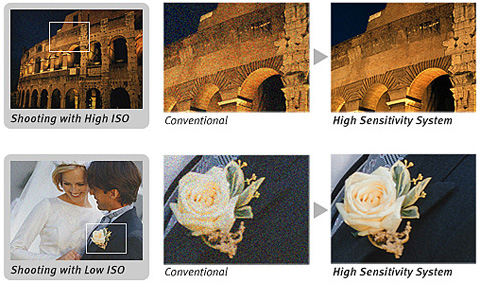
Here Canon themselves show us the benefits of a lower megapixel high sensitivity sensor – cleaner looking images. And yet, they release an EOS 50D camera which had TONS more noise compared to an older model, the 40D. Now they release the EOS 7D, which still features more noise compared to the two year old 40D model. Does this make sense to you?
Now ask yourself, why would Canon equip the G11 with a better sensor with LESS megapixels, that produces better looking images compared to the G10, and still release the EOS 7D, which is supposed to be more advanced than the 40D, with image quality that is clearly featuring more noise compared to the 2 year older 40D? Shouldn’t we expect newer camera models to feature less noise in images?
Update November 12, 2009:
Another review of the 7D has been published showing, and you’re not going to want to believe this, that the 7D performs worse than the entry level Canon EOS 450D (Rebel XSi). Here’s what they had to say:
Again to our eye the 7D files look soft and mushy compared to the snap in the other two files. Of course we expected the flagship Mark III to outperform the mid-priced 7D but we did not expect the entry level Rebel to better the 7D especially when the Rebel’s 12MP files were interpolated to 18MP!
Go over to their site and check the sample images for yourself. Remember that the 450D is now also almost 2 years old.
Update December 2nd, 2009:
A photographer ‘upgraded’ from the 40D to the 7D recently and wasn’t so happy about it:
After a week of playing with my 7D, I noticed the images on my 7D felt a bit soft, especially when comparing it to my 40D. Went online and found some reviews concluding the same thing:
…
Doing my own quick tests, I came to similar conclusions. Using DPP, the 7D produces images that are softer than my 40D at low ISO. I even think the 40D produces less noise at low ISO.
You have been warned.
Update December 13, 2009:
DXOMark have posted their test data for the 7D and you can actually compare the 7D, the 40D and the D300s side by side on their website if you follow this link. The DXOMark test data basically confirms my findings above about the noise in 7D images being worse than the 40D, and that the 40D offers much better image quality compared to the 7D.
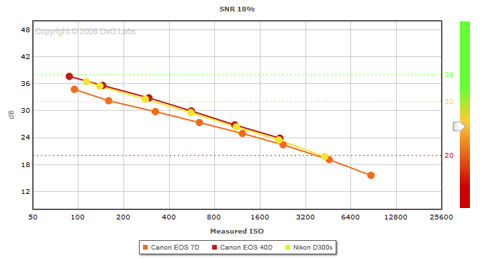
In the graph above you can see that the 7D scores less than the 40D and D300s with regard to noise in images (in the Screen comparison), meaning the 7D has more noise in images compared to the other two cameras. Like I also said, the 40D performs slightly better than the D300s with regard to noise.
Not only does the 40D outperform the 7D with regard to noise in images, but according to DXOMark, the 40D also outperforms the 7D with regard to Tonal Range and Color Sensitivity. This means that the overall image quality is much better on the 40D if the two cameras are compared. Click here to see for yourself on DXOMark.
Imagine what would have happened if Canon had instead improved the sensor in the 40D with the technology used in the 7D. Instead of being behind Nikon, as they are right now, they would have been far ahead.

Comments
There are 200 responses. Follow any responses to this post through its comments RSS feed. You can leave a response, or trackback from your own site.